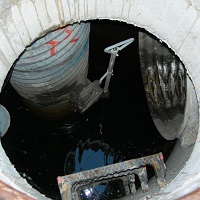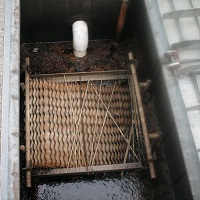Oil / water separator
An oil / water separator treats stormwater by trapping oil at the surface of the water and sediment at the bottom, allowing treated water to pass through. It is most commonly used as the first pre-treatment facility in a series of stormwater management facilities and is usually found in parking lots, service and fuel stations. A unit should be inspected monthly and after a major storm. Make sure to keep records of your inspections and maintenance activities.
Maintenance is needed if you see these signs
Discharge water shows obvious signs of oil or other contaminants
Thick layer of oil (more than 1 inch) on surface of water in vault
Sediment accumulation of more than 6 inches on the bottom of the vault
Accumulation of trash or debris
Plates, baffles or inlet/outlet pipes cracked or damaged
Cracks in pipe joints wider than 1/2 inch and/or evidence of soil particles entering through cracks
Tips for fixing problems and general maintenance
Inspection or maintenance that requires entering the underground facility must be performed by a trained and certified expert. Cleaning and proper disposal of sediment and oils can be done by most environmental contractors. Be sure to keep copies of the disposal records.
Remove trash and debris regularly.
Identify sources of leaks or spills and contain them as quickly as possible.
Oils and sediment should be removed and properly dispsed of (not in the trash).
Secured, floating, oil-absorbant pads can be used to extend the maintenance period.
Additional oil water separator elements
Flow control structure / flow restrictor
Underground flow control structures and flow restrictors direct or restrict flow in or out of facilities. They slowly release stormwater at a specific rate. It is important to make sure they do not become plugged or damaged because the facility could release water too quickly or too slowly and overflow. They are usually found in manholes.
Coalescing plates
Some oil / water separators include coalescing plates (wavy-edged sheets shown above) that separate oil from water, so it can then be skimmed off. Plates should be white when clean.

